 |
 |
|
 |
State, regional leaders celebrate opening of new shared-use facility at Thief River Falls |
 |
 |
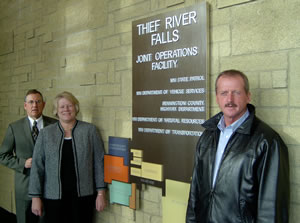 |
|
DNR Commissioner Gene Merriam, Lt. Gov. Carol Molnau and DPS Commissioner Mike Campion helped celebrate the official opening of the new shared highway maintenance facility in Thief River Falls on Nov. 21. Photo by Shawn Groven |
Government, business and civic leaders celebrated a new partnership in Thief River Falls on Nov. 21 with the official opening of the new shared highway maintenance facility.
The building houses offices and shop areas for Bemidji/District 2, the departments of Natural Resources and Public Safety, and Pennington County.
Lt. Gov./Commissioner Carol Molnau, District Engineer Lynn Eaton and other Mn/DOT staff joined the ribbon-cutting celebration at the new building. The $6 million facility is located at the junction of Hwy 59 and Hwy 1 just west of Thief River Falls.
Karen Bedeau, District 2 public affairs coordinator, said scores of people from the community toured the new building’s offices and shops.
Mn/DOT and the county use the facility to conduct highway maintenance operations. The new 65,000 square foot facility also provides new quarters for the district’s construction resident office, its bridge maintenance crew and the regional radio shop operated by Electronic Communications.
The site also provides covered storage for sand, salt and other highway maintenance materials that the district and the county will share.
The DNR’s regional offices now occupy the building. Public Safety uses the building for a State Patrol substation and for the regional site for its Office of Driver and Vehicle Services.
Ron Lagerquist, an architect with the Facilities Service Section in the Office of Maintenance, said the shared facility cuts costs for each agency, encourages resource sharing and promotes the exchange of ideas and expertise among the facilities occupants.
The joint facility at Thief River Falls is the seventh Mn/DOT has constructed in partnerships with other state agencies and county and city governments. Additional joint-use facilities are planned for Ivanhoe, Litchfield and Waseca.
By Craig Wilkins
|
back

|
 |
Slow-moving winter storm leaves icy highways in its wake |
 |
 |
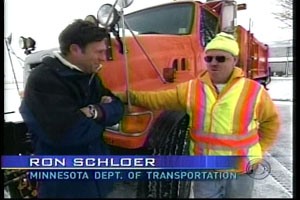 |
|
CBS Evening News reporter Lee Cowen interviews Metro District’s Ron Schloer, a transportation generalist at the Cedar Avenue truck station. Newsclip courtesy of CBS Evening News |
CBS Evening News reporter Lee Cowen ventured to Minnesota to cover the latest storm to hit the region, but traveled only as far as the Twin Cities.
To be certain, the slow-moving Nov. 28-29 storm left its mark on the Twin Cities metro area in the form of snarled traffic, cars sliding into ditches and numerous crashes.
However, if the Dallas-based Cowen had traveled further, he could have seen the western and northern parts of Minnesota which took the full brunt of the season’s first major storm a day earlier.
To see Cowen’s interview with Metro District’s Ron Schloer, a transportation generalist at the Cedar Avenue truck station, go to: http://ihub.clips/archive/05/nov/30/clip05.html.
The storm system whipped up a batch of cold temperatures, rain and snow, then layered it to glaze roads, bridges and virtually everything else.
The storm also closed airports, delayed mail deliveries and caused widespread power outages.
Mn/DOT was forced to close long sections of Interstate 94, Hwy 210 and Hwy 10 due to the storm.
Gov. Tim Pawlenty called out the Minnesota National Guard to help communities in Wilkin County deal with the loss of electric power and other storm-related problems.
Detroit Lakes/District 4 encompasses the hard-hit county. District maintenance crews used their full array of resources in Wilkin County and elsewhere to wrest control of the region’s highways from the storm.
Judy Jacobs, District 4 public affairs coordinator, said wind gusts that reached up to 50 miles an hour further worsened conditions, forcing the district to suspend snowplowing operations for several hours on Monday night.
Further north in Bemidji/District 2, the storm created difficulties for both transportation system users and service providers.
Karen Bedeau, district public affairs coordinator, said the region had freezing rain for two days, then received six to eight inches of heavy snow.
Falling temperatures allowed strong winds to sculpt the wet and snowy highways into virtual bobsled runs of ice.
Bedeau said five district plow operators slid off the road due to icing. One veteran operator, she said, skidded off Hwy 71 near Park Rapids after an oncoming vehicle clipped his plow. The plow slid into the ditch and collided with a van that had spun off the highway earlier. No one was injured in the incident, she said.
District 4 re-opened its closed highways on Tuesday, but most of western Minnesota still has highways with patches of ice or compacted snow that create difficult driving conditions.
Tim Sheehy, District 1 maintenance superintendent, said most of the district received a half-inch of rain during the weekend. The rain, which froze in the district’s northern areas, was followed by as much as a foot of snow in places such as International Falls.
“We’ve been fighting this storm since Sunday and our crews are still out there,” he said. “Our major roads are in good shape but we’ll be working on this for a while longer.”
By Craig Wilkins
|
back

|
 |
Commissioner Molnau to talk live to employees Dec. 8
|
 |
 |
From 1:30-2 p.m. on Dec. 8, Lt. Gov./Commissioner Carol Molnau will talk to Mn/DOT employees in the Central Office cafeteria. The address will be broadcast live to all Mn/DOT employees via streaming video on desktop computers.
The broadcast also will be seen in conference rooms statewide to allow employees without computer access to view the address. Look for information regarding locations in your district.
“I want to thank Mn/DOT employees for the work they have done to meet the challenges of the past year,” Molnau said. “I also want to wish everyone happy holidays and say that I look forward to continuing to work with them in 2006 in meeting Minnesota’s transportation needs.”
After her talk, Molnau will take questions from those in the audience.
Employees who will not be in Central Office on Dec. 8 are asked to submit questions in advance by Dec. 6. As many questions as time allows will be addressed on Dec. 8. Remaining questions will be answered via GroupWise by Dec. 30.
“I look forward to talking to employees on Dec. 8 and also hearing their questions and concerns,” Molnau said.
How to access the Commissioner's address
To see and hear the Commissioner’s address to employees on Dec. 8, go to iHUB and click on the Dec. 8 Commissioner Address entry in the Current Events Calendar section or go directly to the videostreaming site at http://oitvideo/dotlivestream/.
The live talk will appear on your computer screen between 1:30 and 2 p.m. Before that time, you will see a blank screen. Not all department work stations have streaming video capability. Check with your office information technology staff if you are not sure of the capabilities of the computers in your area.
|
|
back

|
 |
Mn/DOT, Public Safety recognized for roadway safety excellence |
 |
 |
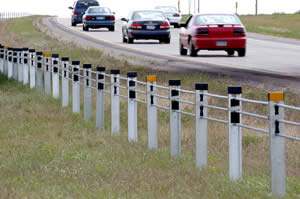 |
|
Cable median barriers like this one on I-94 near Maple Grove are one of the initiatives in the Minnesota Comprehensive Highway Safety Plan for improving traffic safety. Photo by David Gonzalez
|
The Minnesota departments of Transportation and Public Safety received a national 2005 Roadway Safety Award Nov. 15 for the Minnesota Comprehensive Highway Safety Plan. The award was one of 14 given by the Federal Highway Administration and the Roadway Safety Foundation.
“We are very proud of this award and of the CHSP,” said Bernie Arseneau, state traffic engineer and a key architect of the plan. “This has been a collaborative effort involving partners from across the state. And, we believe it gets the job done and provides solutions that we can use to reduce traffic crashes and deaths.”
The CHSP responds to the four traffic safety “E’s”—engineering, education, enforcement and emergency response. It addresses local roadway system needs; reaches out to and coordinates with the state’s safety partners, and addresses traffic safety with an eye to prevention as well as to fixing current problems.
The plan also provides local agencies with resources because almost half of fatal crashes occur on local roadways. The CHSP uses its “Safety Toolbox” to provide local agencies guidance in developing, prioritizing and implementing safety strategies in their jurisdictions.
Loren Hill, State Traffic Safety Engineer, said Mn/DOT and DPS brought together a number of partners from local government, law enforcement and community and traffic safety groups to build the plan.
“The group used a systematic, data- and information-driven process to build the plan,” he said. “It is based on the American Association of State Highway and Transportation Officials Strategic Highway Safety Plan and the National Cooperative Highway Research Program Series 500 Implementation Guides.”
Hill added that the CHSP addresses the state’s crash problems by focusing on the number of lives lost rather than the fatal crash rate.
“The plan’s primary goal is to reduce the number of traffic fatalities to 500 or less per year by 2008, down from approximately 650 fatalities per year currently, and ultimately moving toward zero deaths,” he said.
Two recent CHSP initiatives include the cable median barrier projects in the northwestern part of the Metro area and the year-long speed management program, done in conjunction with DPS, which is providing $2.5 million for additional speed enforcement on state roadways.
The FHWA and the Roadway Safety Foundation present the bi-annual Roadway Safety Awards to programs and projects across the nation exhibiting excellence in roadway design, operations and planning. The Roadway Safety Foundation is a nonprofit charitable and educational organization solely dedicated to reducing the frequency and severity of motor vehicle crashes by improving the safety of America's roadways.
More information about the CHSP is available at www.dot.state.mn.us/trafficeng/safety/chsp/index.html.
|
back

|
 |
Preventing highway crashes, deaths focus of Toward Zero Deaths conference |
 |
 |
 |
|
The annual Toward Zero Deaths conference, held Nov. 16-17 in St. Cloud this year, attracted more than 360 participants. |
Eliminating highway crashes and deaths was the focus of the Toward Zero Deaths Conference on Nov. 16-17 in St. Cloud.
The conference is an annual effort of Mn/DOT, the Department of Public Safety’s Office of Traffic Safety and the Minnesota Toward Zero Deaths program.
More than 360 conference participants chose from 30 different sessions that ranged from training for child passenger safety practitioners to updates on safety programs such as Safe and Sober and the Mn/DOT–DPS speed management program.
The conference opened with an address from a Dakota County family who lost three teenage sons to a crash in 2004 involving a drunk driver. Kathryn Swanson, director of the Department of Public Safety’s Office of Traffic Safety, urged all participants to think over the next two days what each of them could do to help avert such tragedies as the Backstrom family experienced.
The conference ended by revisiting the Backstrom tragedy. Four individuals who worked on some aspect of the crash described their experiences relating to the crash and its aftermath. The speakers included Jill Romann, from the attending coroner’s office; Sgt. Don Schmalzbauer from the State Patrol accident reconstruction team that investigated the accident; Dakota County Deputy Sheriff Char Rayl, who was the first emergency responder on the scene, and Dakota County Attorney Jim Backstrom, who prosecuted the drunk driver. (Backstrom is no relation to the Backstrom family.) The presentation ended with Nathan and Connie Backstrom, parents of the boys killed in the crash, urging participants to help prevent such tragic events from occurring.
The conference also featured 18 exhibitors who displayed some of the latest traffic safety equipment and provided information on various safety programs by several state and local agencies.
More information about the Toward Zero Deaths program, past conferences and current initiatives can be found at its Web site at www.tzd.state.mn.us.
By Kevin Gutknecht
|
back

|
 |
Rick Arnebeck accepts Office of Maintenance director post |
 |
 |
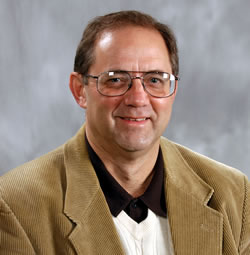 |
Rick Arnebeck's appointment as director of the Office of Maintenance begins Dec. 13. Photo by David Gonzalez
|
Rick Arnebeck, a career engineer and manager, was appointed as director of the Office of Maintenance. He succeeds Mark Wikelius, who recently was named Mn/DOT’s director for the state’s Drive to Excellence program.
Curt Gobeli, assistant director of Maintenance, will serve as acting director until Arnebeck’s appointment begins Dec. 13.
Before accepting his new position, Arnebeck served as a construction project manager with the Metro District. In that role, he facilitated the decision-making process for several major projects including the new St. Croix river crossing near Stillwater.
Previously, he served as an area maintenance engineer in St. Cloud with Baxter/District 3. He also led development of Mn/DOT’s activity-based cost management and budgeting process.
In his new role, Arnebeck will serve as state maintenance engineer and lead statewide maintenance operations. They include snow and ice control, traffic sign installation, pavement management and road maintenance.
Arnebeck’s career with Mn/DOT started in 1974. In addition to his service with Mn/DOT, Arnebeck served as the Winona County engineer from 1984 to 1992.
A Hibbing native, Arnebeck holds a bachelor’s degree in civil engineering and a master’s degree in the management of technology from the University of Minnesota.
He may be reached at 651/297-3590 and by e-mail at. richard.arnebeck@dot.state.mn.us.
|
back

|
 |
Hope Jensen appointed as civil rights director |
 |
 |
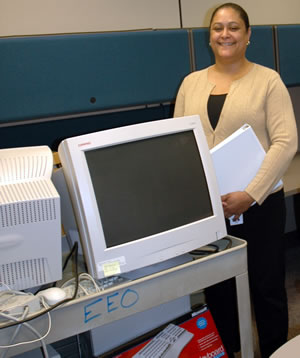 |
|
Hope Jensen, director of the Office of Civil Rights, checks out her new work space on the second floor of the Transportation Building in St. Paul. Photo by Craig Wilkins |
Hope Jensen was named as director of the new Office of Civil Rights. Her appointment begins Dec. 14.
In her new position, Jensen will direct Mn/DOT’s external civil rights programs. They include the Disadvantaged Business Enterprise program and Equal Employment Opportunity Program to ensure federally funded construction projects comply with civil rights laws, on-the-job training programs and anti-discrimination initiatives.
Jensen’s appointment completes reorganization of Mn/DOT’s civil rights enforcement and contract management functions announced in October.
Both functions are now included in the Office of Civil Rights and Administration. The office was formerly known as Administration and Business Services.
Joanne Wagner directs the Office of Contract Management. Her office reviews all contracts to ensure Mn/DOT’s and the contractors’ compliance with state and federal civil rights laws and regulations. Her office was formerly known as Equal Employment Opportunity/Contract Management.
Mike Garza, director of Civil Rights and Administration, said the functions were separated to better define their responsibilities and to improve the effectiveness of the department’s civil rights programs.
Jensen is currently assigned to the Office of Construction Innovative Contracting. She previously served as the design-build chief of staff for the Hiawatha Light Rail project in Minneapolis.
In these positions, she provided legal guidance for construction programs and negotiated funding agreements, contracts and amendments.
Jensen joined Mn/DOT in 1996 as a rules coordinator working in various offices to review and prepare administrative rules and to provide legal research for the department.
Before joining Mn/DOT, she was an administrative aide in the Minnesota House of Representatives, a law clerk for two Minnesota Supreme Court justices and a rules coordinator and hearing examiner for the Department of Public Safety.
Jensen holds a bachelor’s degree in political science from Augsburg College, Minneapolis, and a law degree from the William Mitchell College of Law in St. Paul.
By Craig Wilkins
|
back

|
 |
Gardner accepts post as Freight, Rail and Waterways director |
 |
 |
 |
Bill Gardner took over as director of the Freight, Rail and Waterways Section on Nov. 8. Photo by David Gonzalez
|
Bill Gardner, who serves as project manager for Mn/DOT’s truck size and weight study, was appointed as director of the Freight, Rail and Waterways Section in the Office of Freight and Commercial Vehicle Operations.
He succeeds Al Vogel who retired in July. His appointment began Nov. 8.
Before accepting his current position, Gardner served as director of freight planning and development with FCVO.
Gardner joined Mn/DOT in 1999 as a project manager in the intelligent transportation systems program.
His other experience includes posts with the city of Madison, Wis., the Wisconsin DOT and with transportation consulting and technology firms.
Gardner holds a bachelor’s degree in urban studies from the University of Wisconsin-Madison and a master’s degree in regional planning from the University of North Carolina.
He is a native of Boston, Mass.
Gardner’s office location and telephone remain unchanged. He may be reached at 651/406-4806.
|
back

|
 |
Transit’s Bob Works parlays college bus driving job to honors as a lifetime transit advocate |
 |
 |
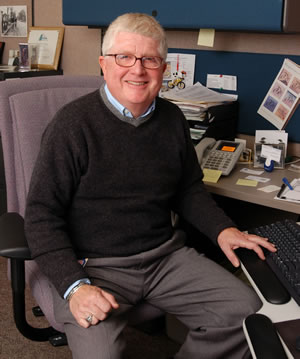 |
|
Metro Transit recently honored Bob Works, Office of Transit, with its lifetime achievement award. Works' career in transit began in 1970 while he was a college student. Photo by David Gonzalez |
Citing his decades of transit innovation and advocacy, Metro Transit honored Bob Works, Office of Transit, with its lifetime achievement award.
The recognition was part of the agency’s annual “Commuter Choice” award program.
Works' career in transit began in 1970 while he was a student at Kent State University in Ohio. He drove for the campus bus service, renovated buses and used computers to process maintenance reports for transit systems such as those in Dallas and Oakland, Cal.
Works later joined the Grand Rapids, Mich., Transit Authority to start its dial-a-ride service, initiate other options and mount a public awareness campaign to increase ridership.
From 1972 until 1979, he served as the assistant director of the Ann Arbor, Mich., Transit Authority.
In 1979, Works was named director of Mn/DOT’s Office of Transit Administration.
As director, Works led the department’s efforts to support transit use and transit system development throughout the state.
“We worked very hard to have transit take its place alongside other transportation modes and saw many successes, especially in the state’s more rural areas,” he said.
Mn/DOT provided financial and technical support to strengthen existing transit services or start new ones in cities such as St. Cloud and dozens of county-based transit services in Greater Minnesota.
Working with Metro Transit and other agencies, Works and staff also launched Minnesota Rideshare, a statewide campaign to promote transit, carpools, the use of bikes and other alternatives to single-occupant autos for commuting.
In 1992, Works shifted his focus to the role of biking and walking in the state’s transportation mix as director of the Bicycle and Pedestrian Program Section in Transit.
Staff members work with other state agencies, cities, counties, the State Bicycle Advisory Board and advocacy groups to expand bikeways, increase the miles of paved highway shoulders that cyclists can use, create bike lanes and raise the profile of bicycling as a transportation mode.
The section completed Mn/DOT’s Bicycle Modal Plan early this year. The plan sets bicycle planning guidance, cites ways to improve safety and viability of bicycle transportation and defines performance targets identified by the Statewide Transportation Plan.
Working with the State Bicycle Advisory Board, the section launched the “Share the Road” campaign this spring that urges cyclists and motorists to follow traffic rules and to share the state’s streets and highways safely and respectfully.
Since his college experience as a bus driver and transit advocate, Works continues his commitment to transit by taking the bus from his home in Bloomington and occasionally making his 20-mile commute to St. Paul via bike.
“Getting people out of single-occupant cars and into a bus or onto a bike and providing mobility for people who can’t drive cuts fuel use, helps the environment, reduces traffic and enriches community life,” Works said. “We plan to keep on doing that.”
By Craig Wilkins
|
back

|
 |
SAFETEA-LU workshop presentations now at your fingertips |
 |
 |
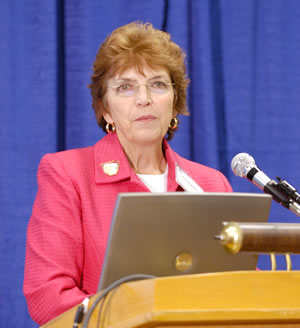 |
|
Donna Allan, director, Office of Transit, was one of the speakers at the Oct. 6 SAFETEA-LU workshop. Her presentation, and others, are now available on Mn/DOT's Web site in both audio and video format. Photo by David Gonzalez |
Audio and video recordings of the eight sessions presented at the Oct. 6 SAFETEA-LU workshop are now available on Mn/DOT's Web site.
SAFETEA-LU—Safe, Accountable, Flexible, Efficient, Transportation Equity Act: A Legacy for
Users—is the six-year federal transportation funding legislation.
The audio and video recordings allow anyone who missed the workshop, or was there but wants to review a particular topic, to view the presentation from the comfort of their own desktop.
Each of the eight presentations is available as a separate file. Presentations include:
- Funding and Finance (32 minutes)
- Highway Programs (25 minutes)
- Planning (23 minutes)
- Environmental (20 minutes)
- Safety/Operations/ITS (35 minutes)
- Transit/Passenger Rail/Bike and Pedestrian (23 minutes)
- Motor Carrier/Rail/Freight/Hazardous Materials (23 minutes)
- Research (17 minutes)
Also available is the welcome and introduction, featuring Lt. Gov./Commissioner Carol Molnau, Robert Johns, Center for Transportation Studies, and Tom Sorel, Federal Highway Administration-Minnesota division.
Visit the SAFETEA-LU Web site at www.dot.state.mn.us/safetea-lu.
By Kay Korsgaard
|
back

|
 |
Newsline receives high marks from survey respondents |
 |
 |
 |
|
The recent Newsline survey received a 53 percent response rate from the 900 surveys randomly distributed to Mn/DOT employees. The results will be used to help improve the newsletter's coverage of news important to the department. |
Mn/DOT Newsline is a well-read and highly rated source of information about department projects and business, according to the responses of a recent newsletter survey administered by Market Research. This view holds true across bargaining units, locations and length of service.
“It is gratifying to learn that employees find Mn/DOT Newsline a good source of department information. My staff, with input from the district public affairs coordinators and others, works hard to ensure that the news we report is timely, accurate and relevant,” said Lucy Kender, Communications director.
“I want to thank the hundreds of employees who took the time to comment on the newsletter. We will consider their responses in making changes to Newsline to ensure that it continues to meet the information needs of the department,” she said.
Sent to a random sample of 900 employees in October, the Mn/DOT Newsline survey drew a 53 percent response rate (480 employees). Employees were asked to respond to 18 questions designed to:
- Evaluate awareness and readership of Mn/DOT Newsline
- Understand use of the newsletter in relationship to other sources of information
- Understand preferences for content, frequency and format
- Understand perceptions of relevance
- Determine whether Mn/DOT Newsline helps employees be knowledgeable ‘ambassadors’ for the department
Almost all employees (94 percent) read the publication at least occasionally, and only 5 percent of employees have never read this publication. Those who have never read Mn/DOT Newsline were more likely to be in AFSCME—6 percent overall, compared to 2 percent in non-AFSCME bargaining units.
According to the survey results, Mn/DOT Newsline was the highest rated source of information about Mn/DOT projects and transportation issues. Other sources, rated from high to low, were Employeeline, Mn/DOT’s Web site, district newsletters, supervisors, co-workers, news media, e-mails from district public affairs coordinators and memos from management.
For the most part, survey respondents felt the content of the newsletter is about right, though many would like more information about projects in their districts/offices and employees on the job.
Mn/DOT Newsline has been a Web-based employee newsletter since February 2001 when it replaced the monthly print tabloid, Mn/DOT News, and the weekly e-mail,DOT Connection, as the department’s official source of transportation news. The electronic format and increased frequency of publication were intended to provide employees with more timely information about key transportation issues and expand the world of information available to its readers by offering links to other Web sites.
For more information about the Mn/DOT Newsline survey or about Market Research at Mn/DOT, contact Lori Laflin at 651/296-1659, or Chris McMahon at 651/284-3243.
|
back

|
 |
|
 |



